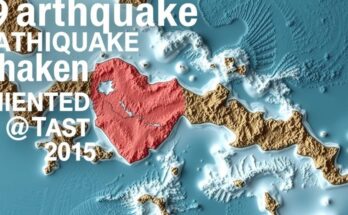A 3.4-magnitude earthquake occurred in New Mexico on November 21, 2024, at a depth of 7.3 kilometers. This event followed various significant quakes including a 2.7-magnitude in California, 6.6-magnitude in Papua New Guinea, and more, indicating a pattern of global seismic activity over a brief period.
On November 21, 2024, a 3.4-magnitude earthquake struck New Mexico, as reported by the United States Geological Survey (USGS). The earthquake, which occurred at a depth of 7.3 kilometers (approximately 4.5 miles), was centered in the Alum Rock area. At the time of publication, the USGS had received a single report detailing that a person felt the tremor.
This recent seismic activity in New Mexico follows a series of earthquakes within a short period, including a 2.7-magnitude quake in California on November 19, which was centered in Alum Rock at a depth of 6.4 kilometers (around 4.0 miles). Additionally, the California event came in the wake of a more significant 6.6-magnitude earthquake that was reported in Papua New Guinea on November 15. This quake was centered in Kokopo and occurred at a depth of 51.9 kilometers (approximately 32.2 miles).
Prior to the Papua New Guinea earthquake, a 5.0-magnitude quake was recorded in Mexico on November 13, with its epicenter located in Santiago Tepextla at a depth of 12.6 kilometers (around 7.9 miles). The seismic activity in Mexico coincided with a 4.2-magnitude earthquake in Australia, as reported shortly before, which was centered in Denman at a depth of 11.1 kilometers (approximately 6.9 miles).
The trend of significant earthquakes continued with a 4.4-magnitude event in India on November 12, located in Gyalshing at a depth of 10 kilometers (about 6.2 miles). Furthermore, the latter part of November witnessed successive tremors in Cuba, including a 5.9-magnitude quake followed closely by a 6.8-magnitude earthquake. These earthquakes occurred before a 5.8-magnitude quake was recorded in Panama, centered in Burica at a depth of 10 kilometers (approximately 6.2 miles).
On November 8, a 6.2-magnitude earthquake struck Chile, occurring in Cochrane at a depth of 10 kilometers (about 6.2 miles), shortly after a 5.0-magnitude quake was detected in Peru on November 7. Peru’s earthquake was announced just prior to another 4.4-magnitude quake reported in California. This series of geological activities underscores a global pattern of seismic events that were highlighted in the reports by USGS, further showcasing the dynamic nature of geological activity across various regions.
Finally, the sequence of earthquakes included notable reports from Greece on November 5 (4.4-magnitude) in Chalandrítsa at a depth of 82.3 kilometers (approximately 51.1 miles) and Hawaii, which subsequently experienced a 4.8-magnitude earthquake centered in Pāhala at a depth of 38.4 kilometers (about 23.9 miles).
Earthquakes are geological phenomena characterized by the sudden release of energy in the Earth’s crust, resulting in seismic waves. The United States Geological Survey (USGS) is a scientific authority that monitors and reports on seismic activity across the globe. Understanding the details of these occurrences is critical for public safety and disaster preparedness. This particular report highlights not only events in the United States but also significant seismic activities that have transpired in various regions worldwide, showcasing the interconnectedness of geophysical processes. Records indicate that these tremors can occur sequentially, reflecting ongoing geological stress and activity beneath the Earth’s surface, often resulting in heightened concerns for communities in affected areas.
In conclusion, the 3.4-magnitude earthquake in New Mexico on November 21 marks a continuation of significant global seismic activity, with notable quakes reported in California, Papua New Guinea, Mexico, and several other countries within the same timeframe. These events underscore the dynamic nature of the Earth’s geological processes and highlight the importance of monitoring such activities for public awareness and safety.
Original Source: www.iheart.com




